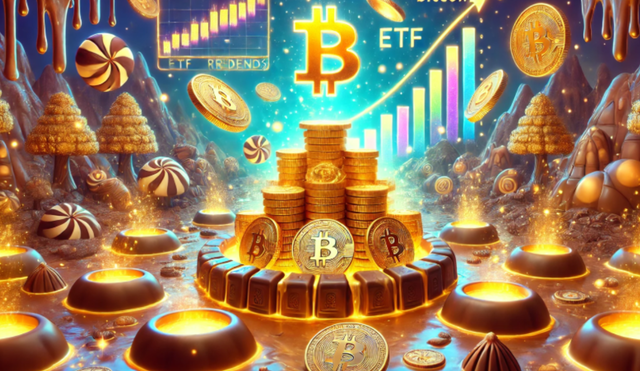The World of Magic Chocolates: Understanding Bitcoin, ETFs, and the Halving
Bitcoin, limited to 21 million units, is becoming increasingly scarce. With the halving in April 2024, production will decrease even further, intensifying competition for BTC availability.

In just seven days, U.S. Bitcoin ETFs bought over 8,775 BTC, while miners only managed to produce 3,150 BTC. That means funds bought nearly three times more Bitcoin than was created.
But what does this mean, and why is it so important?
Bitcoin Is Scarce, Like Gold (But Digital)
Bitcoin has an unbreakable rule: only 21 million will ever exist. Unlike traditional money, which governments can print without limit, Bitcoin cannot be duplicated or manipulated. Every new BTC must be “mined,” a process that requires time, energy, and computing power.
Currently, miners create 6.25 BTC every 10 minutes, which amounts to:
- 900 BTC per day
- 6,300 BTC per week
But… in April 2024, the halving is coming, cutting that number in half: 3.125 BTC every 10 minutes.
This means that after the halving, only 450 BTC will be produced per day. That makes each BTC more valuable over time, especially when demand outpaces supply.
What Is a Bitcoin ETF?
An ETF (Exchange-Traded Fund) allows individuals and institutions to invest in Bitcoin without buying it directly. Instead of storing BTC in a wallet, they purchase ETF shares, and the fund handles buying and securing real Bitcoin.
These funds are financial giants. The mere fact that they are buying thousands of BTC per week creates strong buying pressure in the market.
What Happens When ETFs Buy More Bitcoin Than Is Produced?
It means they’re draining the market. If miners produce 3,150 BTC, but ETFs buy 8,775 BTC, the difference has to come from somewhere: from existing BTC that someone must decide to sell.
However, more and more holders are keeping their BTC. Many believe in its long-term value, so they prefer not to sell. The result? Extreme scarcity that can trigger a rapid price increase.
And with the halving so close, production is about to drop even further… just as demand continues to rise.
The Tale of the Magical Chocolates
Imagine a world where only 3,150 magical chocolates are created each week. These chocolates are highly desired because they cannot be copied, don’t melt, and everyone wants them.
One day, the Big Funds (ETFs) arrive and say:
—“We want to buy 8,775 chocolates this week.”
But… only 3,150 new ones exist! So they have to go out and find existing ones. They need to convince holders to sell.
And of course, with many buyers and few sellers, the chocolate owners say:
—“If you want one, pay me more.”
And the price… goes up.
Moreover, very soon, due to a magical law, only 1,575 chocolates will be created per week. So, if demand stays the same or increases, but there are fewer chocolates…
Each chocolate becomes even more valuable.4o